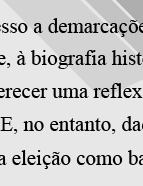

................................
Contrary to other historiographies, such as the Italian or French, attention and prominence have not been given to the 'anonymous' figures in Portugal to date, as the new trends of the mid-century appeared to announce. In the Marxist tradition, although at times this anonymous mass took shape, what opposed the dominant model within the field of biography was, above all, a revision of previous versions in light of a conception of history focused on major processes rather than a fundamental subversion of the criteria determining the prominence of major figures. This exercise, however, was sketched out around the same time, albeit limited in scope from the perspective of a reflection on the hierarchisation of historical agents. It can be identified, especially among those who were most affected by and adopted the new themes and methodologies developed within the framework of the New History. Here, the closest examples of "modal" type biography (G. Levi) may be found, in which so-called "average" characters serve as a gateway to reconstructing processes, periods, or social categories. However, as historiography rarely stripped protagonists of their exceptionalism or power of intervention in the course of history, these examples represented the most complete manifestations of the generalising capacity of the life portrait. This exercise was not new: specific periods and phenomena in Portuguese history, not only in methodical tradition, were often accessed through 'minor' and great names, such as Mário Brandão in works on the Inquisition Court or the Viscount of Lagoa in the project to reconstruct the history of national expansion towards the East through an exhaustive collection of lives among the "great and humble" figures. They were not, nor would they yet be the truly marginalised figures of history nor, strictly speaking, the "average" characters that dissolved into the context, but rather those representatives who had been relegated by historiography to secondary roles in favour of more prominent figures: such as the forgotten parliamentarians of Oliveira Marques, the Tristão da Cunha seen by Banha de Andrade as a means to reconstruct politics and administration in the 16th century, or the merchants and bankers who, in Virgínia Rau's work, coexisted with the more conventional profile of D. Catarina de Bragança (Giovanni Levi, “Les usages de la biographie”, 1989, p.1329; B. Andrade, História de um fidalgo quinhentista português, 1974, p.14).
